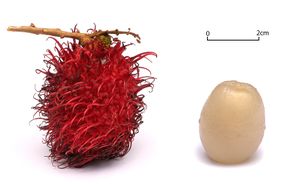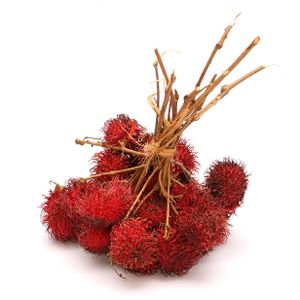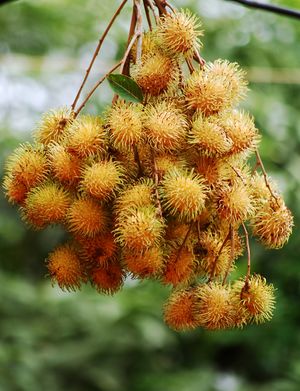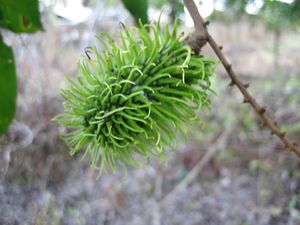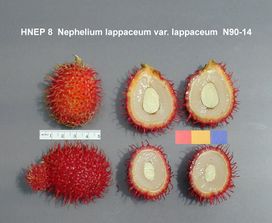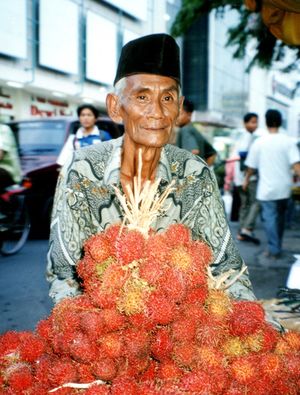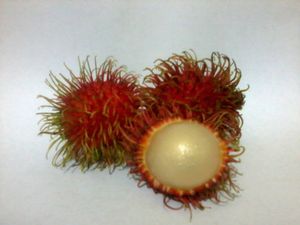رامبوتان
|
| ||||||||||||||||||||||||
رامبوتان : نافَلْيون أو رامبوتان (بالإنجليزية: Rambutan) هي شجرة استوائية من الحجم المتوسط في كما أن الاسم يطلق أيضاً على ثمرة هذه الشجرة. يعود أصل الشجرة إلى ماليزيا واندونيسيا وسريلانكا وجنوب شرق آسيا، على الرغم من أن دقة التوزيع الطبيعي للشجرة غير معروفة. ترتبط ثمرة النافَلْيون أو الرامبوتان ارتباطاً وثيقاً بعدة أنواع أخرى من الفواكه الاستوائية الصالحة للأكل بما في ذلك الليتشي، عين التنين، والمامونسيللو. ومن المعتقد أن يعود أصل الشجرة إلى أرخبيل الملايو. الرامبوتان في اللغات الإندونيسية والفلبينية والماليزية تعني حرفيا شعر وسبب هذه التسمية هو 'الشعر' الذي يغطي هذه الفاكهة. كما أن هذه الفاكهة تسمى في تايلاند ب(نغوه). في بنما، وكوستاريكا، ونيكاراغوا تُعرف هذه الفاكهة باسم تشينو مأمون. وهناك نوع آخر يُباع بانتظام في أسواق الملايو تُعرف باسم الرامبوتان البرية حيث أنها أصغر قليلا من المعتاد ومتنوعة الألوان من الأحمر إلى الأصفر. القشر الخارجي للفاكهة يتم تقشيره ويظهر لب الفاكهة الجاهز للأكل. أما عن مذاقه فهو من حلو إلى حامض كما أنه أحيانا يشبه طعم العنب.
الوصف
هي شجرة خضراء تنمو إلى ارتفاع 10-20 متر. الأوراق بطول 10-30 سنتيمترا، ريشية الشكل، مع نشرات 3-11، 5-15 سم كل نشرة على نطاق واسع 3-10 سم، مع هامش بأكمله. الأزهار صغيرة قطرها 2.5-5 مم. النافَلْيون أو الرامبوتان من الأشجار التي إما أن تكون من الذكور (ذو سداة الزهور المنتجة فقط، وبالتالي لا تنتج الفواكه) ،أو الإناث (إنتاج الزهور التي ليست سوى وظيفيا أنثى)، أو خنثى (إنتاج الزهور التي هي الأنثى مع نسبة مئوية صغيرة من الزهور من الذكور). الثمرة الفاكهة هي بيضاوية الشكل يبلغ قطرها 3-6 سم (نادرا ما تكون إلى 8 سم) طويلة القامة. القشرة مصنوعة من الجلد المحمر (نادرا ما البرتقالي أو الأصفر)، ومغطى من العمود الفقري بطبقة من الشعر، ومن هنا جاءت تسميته «الرامبوتان، المستمدة من الملايو كلمة رامبوت «rambut وهو ما يعني الشعر. الثمرة شفافة، بيضاء أو وردية باهتة جدا مع طعم حلو، ونكهة معتدلة الحموضة.
الزراعة
Cultivars
Well over 200 cultivars were developed from selected clones available throughout tropical Asia.[3] Most of the cultivars are also selected for compact growth, reaching a height of only 3–5 m for easier harvesting.
Nutrients and phytochemicals
| القيمة الغذائية لكل 100 g (3.5 oz) | |
|---|---|
| الطاقة | 343 kJ (82 kcal) |
20.87 g | |
| ألياف غذائية | 0.9 g |
0.21 g | |
0.65 g | |
| الڤيتامينات | |
| ثيامين (B1) | (1%) 0.013 mg |
| ريبوفلاڤين (B2) | (2%) 0.022 mg |
| نياسين (B3) | (9%) 1.352 mg |
| ڤيتامين B6 | (2%) 0.02 mg |
| فولات (B9) | (2%) 8 μg |
| Vitamin C | (6%) 4.9 mg |
| آثار فلزات | |
| كالسيوم | (2%) 22 mg |
| حديد | (3%) 0.35 mg |
| الماغنسيوم | (2%) 7 mg |
| المنگنيز | (16%) 0.343 mg |
| فوسفور | (1%) 9 mg |
| پوتاسيوم | (1%) 42 mg |
| صوديوم | (1%) 11 mg |
| زنك | (1%) 0.08 mg |
| |
| Percentages are roughly approximated using US recommendations for adults. Source: USDA Nutrient Database | |
Rambutan fruit contains diverse nutrients but in modest amounts, with only manganese having moderate content at 16 percent of the Daily Value per 100 g consumed (right table; note data are for canned fruit in syrup, not as raw which may have different nutrient contents).
As an unpigmented fruit flesh, rambutan does not contain significant polyphenol content,[4] but its colorful rind displays diverse phenolic acids, such as syringic, coumaric, gallic, caffeic, and ellagic acids having antioxidant activity in vitro.[5][6] Rambutan seeds contain equal proportions of saturated and unsaturated fatty acids, where arachidic (34%) and oleic (42%) acids, respectively, are highest in fat content.[7]
The pleasant fragrance of rambutan fruit derives from numerous volatile organic compounds, including beta-damascenone, vanillin, phenylacetic acid, and cinnamic acid.[8]
Gallery
انظر أيضاً
References
- ^ Barstow, M. (2017). "Nephelium lappaceum". IUCN Red List of Threatened Species. 2017: e.T33266A67808476. Retrieved 28 May 2020.
- ^ Nephelium lappaceum (TSN {{{ID}}}). Integrated Taxonomic Information System.
- ^ خطأ استشهاد: وسم
<ref>غير صحيح؛ لا نص تم توفيره للمراجع المسماةmorton - ^ "Comparative content of total polyphenols and dietary fiber in tropical fruits and persimmon". J Nutr Biochem. 10 (6): 367–71. 1999. doi:10.1016/s0955-2863(99)00017-0. PMID 15539312.
{{cite journal}}: Cite uses deprecated parameter|authors=(help) - ^ "Identification of major phenolic compounds from Nephelium lappaceum L. and their antioxidant activities". Molecules. 15 (3): 1453–65. 2010. doi:10.3390/molecules15031453. PMC 6257335. PMID 20335993.
{{cite journal}}: Cite uses deprecated parameter|authors=(help)CS1 maint: unflagged free DOI (link) - ^ "Preparation of free, soluble conjugate, and insoluble-bound phenolic compounds from peels of rambutan (Nephelium lappaceum) and evaluation of antioxidant activities in vitro". J Food Sci. 77 (2): C198–204. 2012. doi:10.1111/j.1750-3841.2011.02548.x. PMID 22250923.
{{cite journal}}: Cite uses deprecated parameter|authors=(help) - ^ "Physico-chemical characterisation of the fat from red-skin rambutan (Nephellium lappaceum L.) seed". J Oleo Sci. 62 (6): 335–43. 2013. doi:10.5650/jos.62.335. PMID 23728324.
{{cite journal}}: Cite uses deprecated parameter|authors=(help) - ^ "Characterization of Volatiles in Rambutan Fruit (Nephelium lappaceum L.)". J Agric Food Chem. 46 (2): 611–615. 1998. doi:10.1021/jf970665t. PMID 10554286.
{{cite journal}}: Cite uses deprecated parameter|authors=(help)
